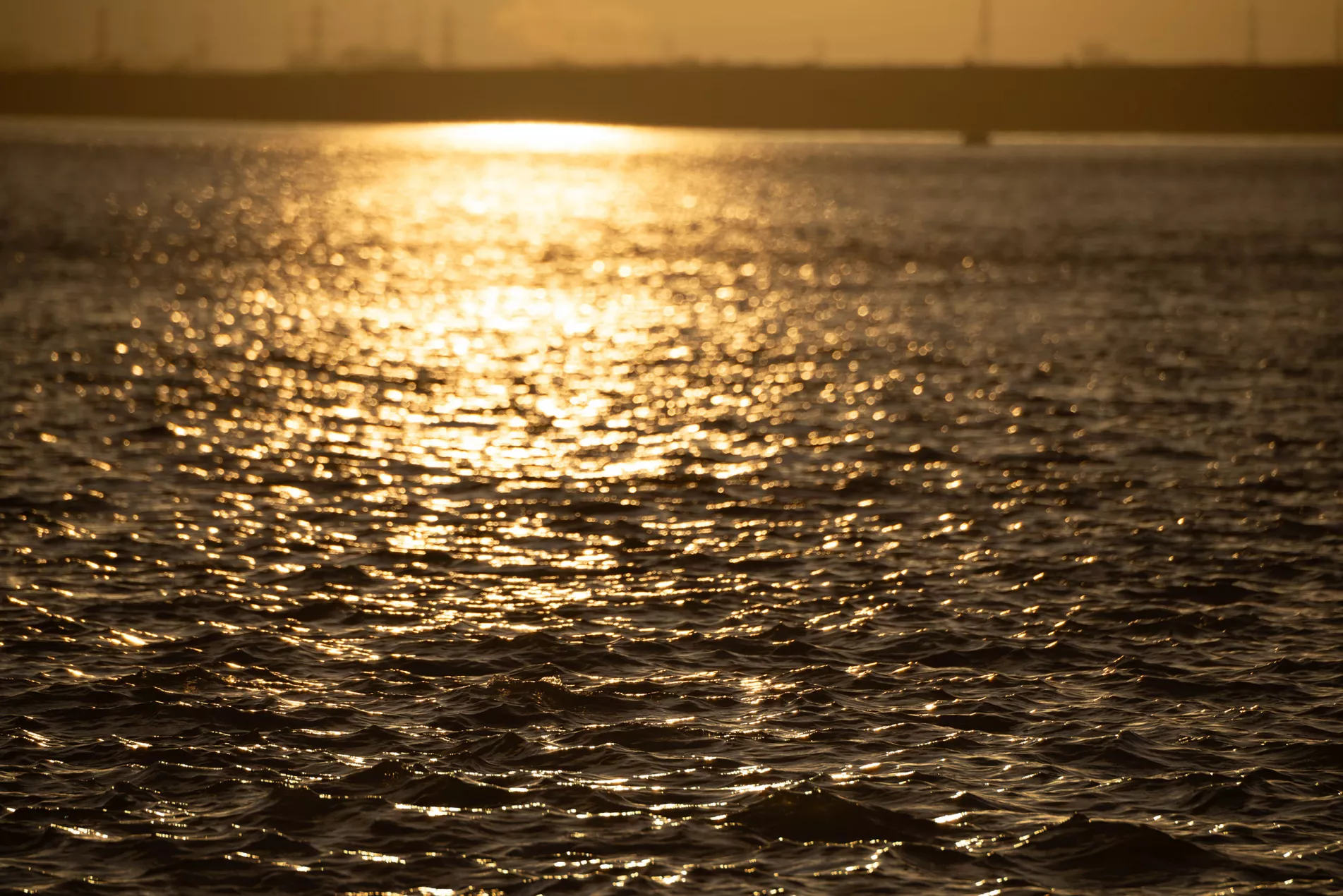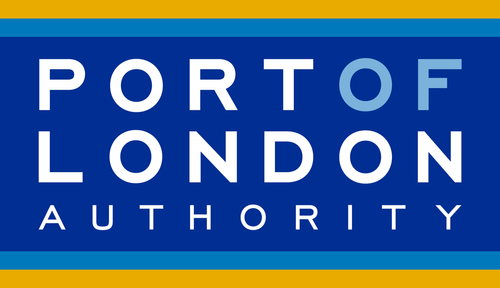Live Tides
NOTICES TO MARINERS
Charts & Surveys
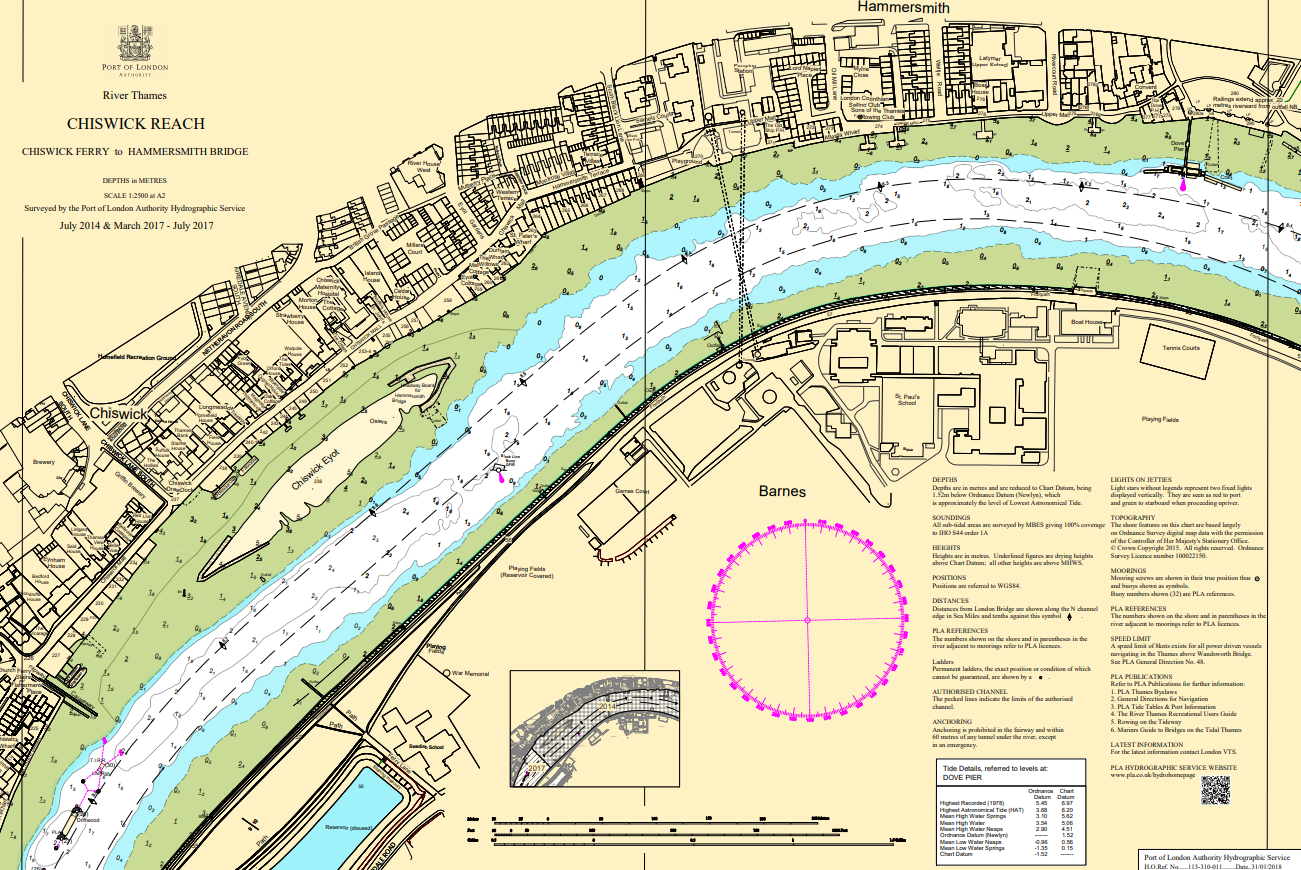
Incident reporting
Life-threatening emergencies on the river:
Call 999 and ask for the Coastguard
For near miss, safety observations and incident reporting click below
Latest PLA investment prepares east London wharves for return to operation

Construction teams are busy preparing two east London wharves to return to operation in 2022, in a £2.6 million programme of essential improvement works for the Port of London Authority (PLA).
One hundred steel piles, each 22.5 metres long and weighing five tonnes are being driven into the 200-metre-long quayside at the adjoining Plaistow and Royal Primrose wharfs in Newham, East London. The piles will provide a stable platform for a new concrete deck to be installed.
The construction arm of Plaistow Wharf tenant, Keltbray Environmental, is undertaking the site works. Keltbray is due to welcome the first cargo carrying barges to the site early in the New Year.
The PLA acquired three adjacent wharfs, Peruvian, Plaistow and Royal Primrose over the last five years as part of its Investment Plan, in order to bring them back into use for cargo handling. The PLA’s total investment in site acquisition and improvements readying them for operations is some £20 million.
PLA director of planning & environment, James Trimmer, said:
“These site works are the latest, essential stage in getting these wharfs back into use. By the end of next year, Plaistow and Royal Primrose wharves will, like Peruvian, be occupied by tenants and busy handling cargo. Together they form the riverside heart of a cluster of marine/industrial activity in East London, underpinning the low carbon movement of cargoes along the river, keeping lorries off the capital’s congested road network.”
Peruvian Wharf, the first to return to operation, is home to Brett Group’s Capital Concrete operation. It was officially opened in 2019 by London’s deputy mayor for planning, regeneration and skills, Jules Pipe CBE.
The quayside deck slabs for Plaistow and Royal Primrose will be cast on site, using Capital Concrete from Peruvian Wharf. Work readying the site for cargo handling will include re-grading the riverbed alongside the wharf and installing berthing piles ready for ships to come alongside.
Related content
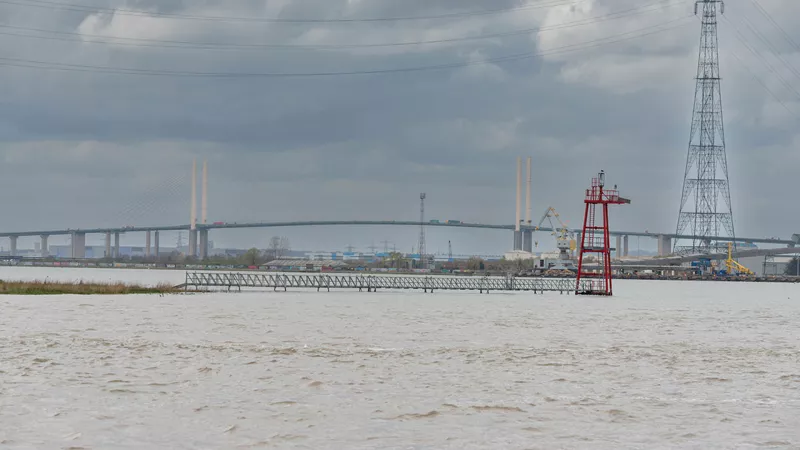

Location: London/Gravesend Remuneration: £28,971 per annum for a commitment of up to 24 days per...
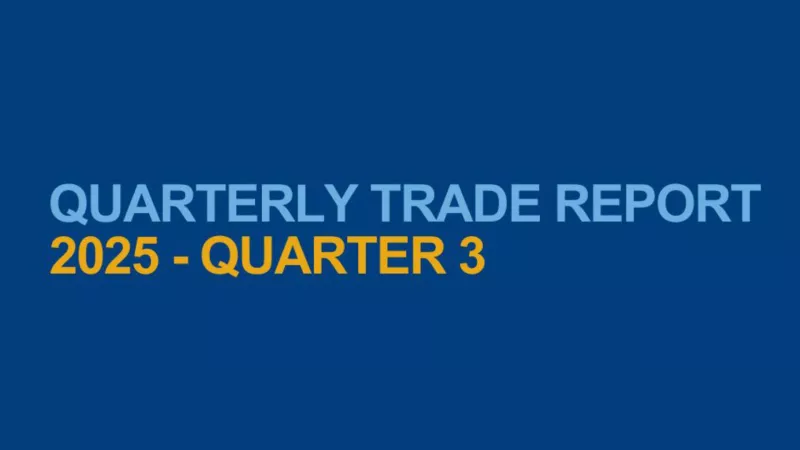
A calling to help the Thames meet new challenges
Christopher Rodrigues

Early next year, it will be farewell to the Port of London Authority - but not the river - for our chairman, Christopher Rodrigues CBE. Since 2016, he has seen the PLA change radically - and is confident we are well placed to help the river meet the new challenges it faces.
A river calling
“I was born at Bart’s Hospital, within the sound of Bow Bells, and grew up in Notting Hill - before it became smart!
“My first memory of the river is a day out on my uncle Bob’s Thames cruiser, somewhere near Shepperton in the 1950s.
“I got an ear infection from swimming in the river.
“Since I was child the river has been transformed.
“It’s the beating heart of London, no longer a dull, grey sewer.”
A rower in the making
“At school in Hampstead, I was awful at cricket.
“By chance, I was sent to the river for remedial training and fell in love.
“I have never looked back.
“Nothing clears the mind or the lungs like an outing on the river.
“To this day, just sitting anywhere by the river makes me happy, especially on a sunny day.”
Working life
“My first job was selling dog food for Spillers, based in Royal Victoria Dock - while training, but unfortunately failing, to secure a place in the 1972 Olympic rowing squad.
“It was my fellow Tideway sculler, Bill Barry, who introduced me to the world of advertising and marketing. The rest is history.
“A desire to do good for the river and have fun was what inspired my application to chair the PLA. It’s a great gig.
“Naturally, I would love to stay on longer, but it’s time for someone new to take the helm.”
PLA progress
“The highlight for me has been seeing the team grow over the past six years to become genuine custodians of the tidal Thames, invested in preserving and enhancing all aspects of life on the river – commercial, environmental, cultural and sporting.
“We’ve learned to collaborate much more effectively too.
“I am proud that the organisation these days has a strategic, as well as operational focus, a journey instigated by my much-missed predecessor, Helen Alexander.
“Our investment strategy, for example, has concentrated on re-opening disused wharfs, which will be an all-important catalyst for more freight and more jobs on the river.
“The PLA has a secure financial footing and a strong, diverse workforce in place, with lots of young talent coming up through the ranks.”
Back in top spot
“It would be remiss of me not to mention that London is now, after more than two decades, once again the country’s biggest port by volume.
“That news did make me happy, I must confess. I am a competitive soul.”
Future challenges
“Producing the Thames Vision has been a major achievement.
“The exciting challenge for my successor will be revising the Vision goals, to make sure they are aligned with new circumstances - post Brexit and post the pandemic, not least climate change and the journey to achieving Net Zero.
“The world has changed, and the PLA must change with it.
“We can’t achieve our goals on our own, so working in partnership with all sections of the river community will be increasingly important.
“Inevitably, there will be some trade-offs.
“The population is growing and river use is increasing, but the river isn’t getting any bigger.
“Trade, recreation and the natural Thames are the three pillars on which our future must be built.
“My strong view is that a ‘coalition of the willing’ is required to deliver our shared ambitions for the river.”
A ring side seat
“Actually, I am not going too far away.
“In my new role, chairing the Maritime & Coastguard Agency (MCA), I am looking forward to keeping abreast of what is happening on the country’s premier waterway.
“The PLA and the MCA share a common de-carbonisation agenda.
“It’s not going to be easy, but I am a great believer in positive thinking.”
Training matters
“I have been a member of the Company of Waterman & Lightermen since 1999.
“It’s a wonderful group of people, who are all passionate about the river.
“I’m delighted that, in partnership with the Thames Skills Academy and the PLA, the Company is driving forward a Continuous Professional Development (CPD) programme for all river workers.
“Safety must remain the priority focus for all of us.
“As the river gets busier, the potential dangers increase.
“Whether you have worked on the river for a long time, or are just starting out, the programme will ensure your skills are up to date, improve your employability and, most importantly, stop avoidable accidents on the river.”
A sport for all
“My proudest moment as a rower was my second appearance in the University Boat Race, in 1971, when we beat Oxford – “The Dark Side” – by ten lengths, in what was then the second fastest-ever time.
“It’s been topped only by watching my son triumph in the Princess Elizabeth at Henley1998.
“I am still actively involved in the sport, getting the oars out as often as I can, and I serve as a steward of the Henley Regatta.
“I think that some people’s perception of the sport as elitist is unfair.
“Back in 1971, we lost the final of the Stewards’ Challenge Cup at Henley to a crew from Thames Tradesmen RC.
Important diary date
“Like many others, I am greatly looking forward to the Boat Race returning to the Thames on 3 April 2022.
“The two-year absence has been too long.
“For all the crews, I am sure it will feel like coming home.
“As I can personally testify, nothing beats the feeling of overcoming the challenges of the Championship course, from Putney to Mortlake.
Quick fire
- The river in three words? Pleasure. Camerarderie. Spiritual.
- Top Thames-side watering hole? The balcony of Leander is pretty good.
- Interests, beyond the river? Opera, ballet, cooking and my family.
Related content


Location: London/Gravesend Remuneration: £28,971 per annum for a commitment of up to 24 days per...

Laser scans show devastating impact of wet wipes on the Thames
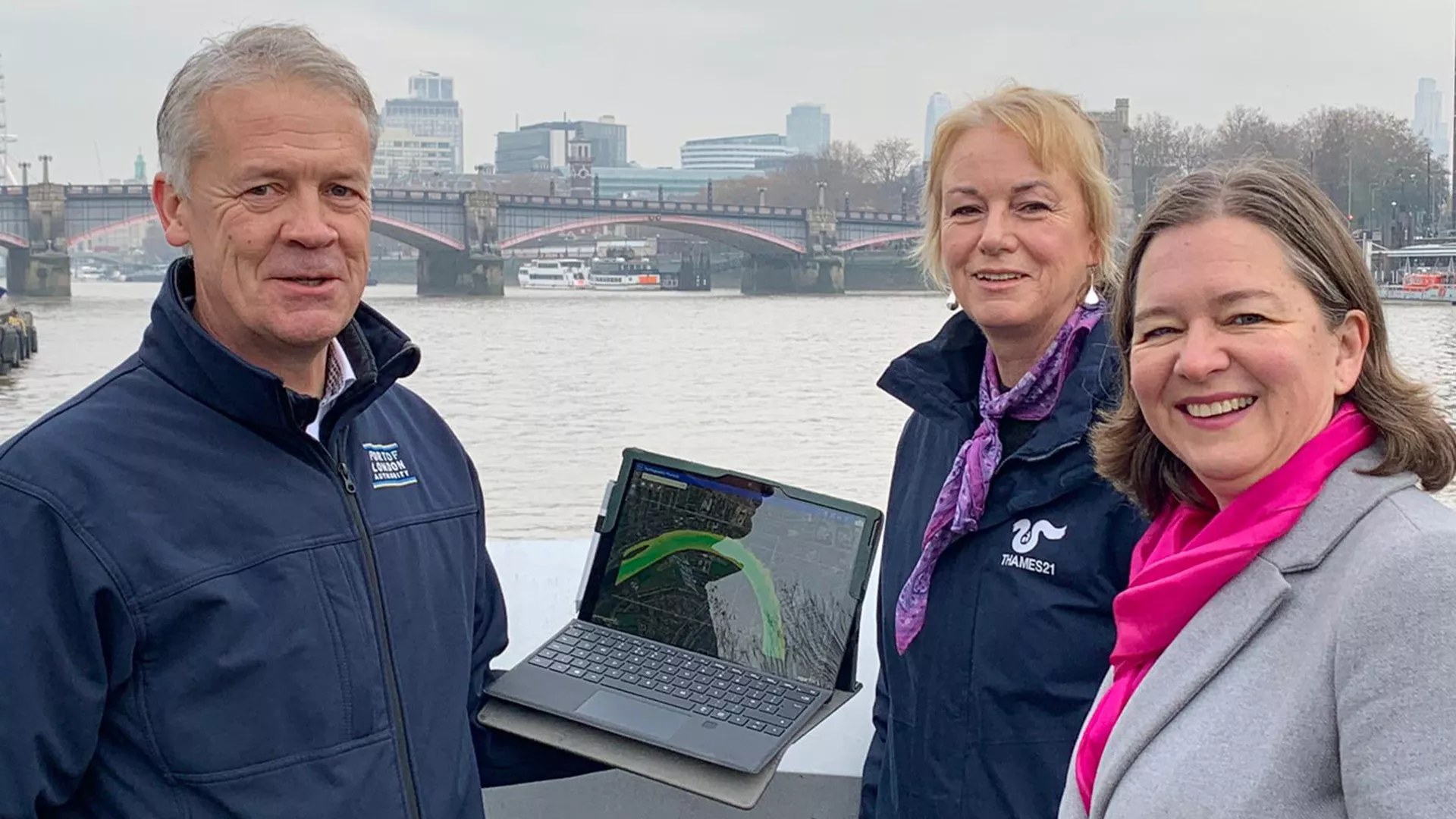
River charity Thames21 has today released data showing a mound created by wet wipes, which has grown to the size of two tennis courts and over a metre tall in the past six years.
 High-resolution sonar and laser scans of the riverbed of the Thames in west London have been collected along the River Thames in Hammersmith as part of work to build London’s new super sewer, which will tackle 95% of sewage overflows that currently pollute the river.
High-resolution sonar and laser scans of the riverbed of the Thames in west London have been collected along the River Thames in Hammersmith as part of work to build London’s new super sewer, which will tackle 95% of sewage overflows that currently pollute the river.
Although the super sewer will help reduce sewage litter into the river, environmental campaigners are today reminding people of the damage wet wipes can do and the importance of keeping them out of the sewage network.
With all-party support, a Ten-Minute Rule Bill, proposed by Fleur Anderson MP (Labour Putney), which would outlaw the use of plastic in wet wipes, is due to have its second reading on 26 November. Fleur Anderson said: “We use 11 billion wet wipes every year in the UK and 90% of them contain plastic. Flushing the odd wet wipe may not seem like a big deal, but there are 300,000 blockages every year in our sewers. Since my 'Ban plastic in Wet Wipes' Ten-Minute Rule Bill had its first reading on Tuesday 2 November, I have been blown away by the amount of coverage and cross-party support the campaign has received.”
Debbie Leach, CEO of Thames21, said: “This data is a stark reminder of the damage wet wipes cause to our natural ecosystems. We are fully supportive of removing plastic from wet wipes and look forward to the day when the river is free from this pollution.”
When wet wipes, currently usually made of plastic, get into the Thames, they bind with natural sediment to create large mounds. Literally changing the contours of the river, this pollution poses a growing threat to the river’s flourishing wildlife.
Tideway regularly carries out surveys of the riverbed and foreshore as part of its work to build London’s new super sewer, due to be completed in 2025.
John Sage, head of corporate responsibility at Tideway, said: “Once complete, the super sewer will capture more than 95% of sewage overflows into the River Thames. While this will help tackle some of the sewage-related litter that ends up in the river, we all have a duty to ensure we are disposing of our rubbish correctly.”
Tideway supports Thames21’s Thames River Watch programme, which monitors plastic pollution in the Thames. In September, Thames21 volunteers logged 27,400 wet wipes at Battersea Bridge in just two days.
Robin Mortimer, chief executive of the Port of London Authority (PLA), said: “Tackling the needless pollution of the river must be a priority for everyone that cares about its future. The Thames Tideway Tunnel will be a major boost to the health of the capital’s waterway, but everyone can play their part right now, by avoiding plastic wet wipes and ensuring that they flush only the three ps – pee, poo and paper.”
Anna Boyles, Thames Water's operations manager, said: "We know many busy families love the convenience of wet wipes, but most are made from plastic and can take centuries to biodegrade. It’s like flushing a plastic bag down the loo.
"Some wipes are marketed as ‘flushable’. All that means is that they will disappear down the u-bend, but they're not gone for good and could end up clogging your pipes or in the river. We’re working to influence manufacturers to properly label their products and, even better, to remove the plastic from the wipes altogether. If you’re using standard wet wipes, please pop them in the bin instead of the toilet.
"We’re also working with the government, Ofwat and the Environment Agency to accelerate work to stop these unacceptable discharges of untreated sewage and sewage litter from happening in the first place."
Related content


Location: London/Gravesend Remuneration: £28,971 per annum for a commitment of up to 24 days per...

River Thames careers kickstarted
Two “kickstarter” trainees have secured longer-term contracts with the Port of London Authority (PLA).
Following six-month placements as part of the governments Kickstart scheme, designed to help unemployed young people get their foot on the career ladder, Enrik Hoxha, from Gravesend, and Sean Holdforth, from Welling, are both now on the PLA’s payroll. Their roles will be reviewed at the end of 2022.
Enrik (22) works in the IT department and has played a key role, helping staff work online from home during the pandemic.
Sean (23) is a data and performance monitoring assistant in the PLA’s environment team. His role involves surveying the foreshore of the Thames for litter and biodiversity.
Enrik said: “I’m glad I applied for the Kickstart scheme- I enjoy my role so I’m really pleased our contracts have been extended.”
Sean added: “The scheme lasts six months but it can lead to a longer-term opportunity.”
Glenn Witham, PLA director of HR, said: “The Kickstart scheme has done exactly that; kickstarted careers.
“These young people are the future of the PLA, so it’s great we can provide this opportunity.”
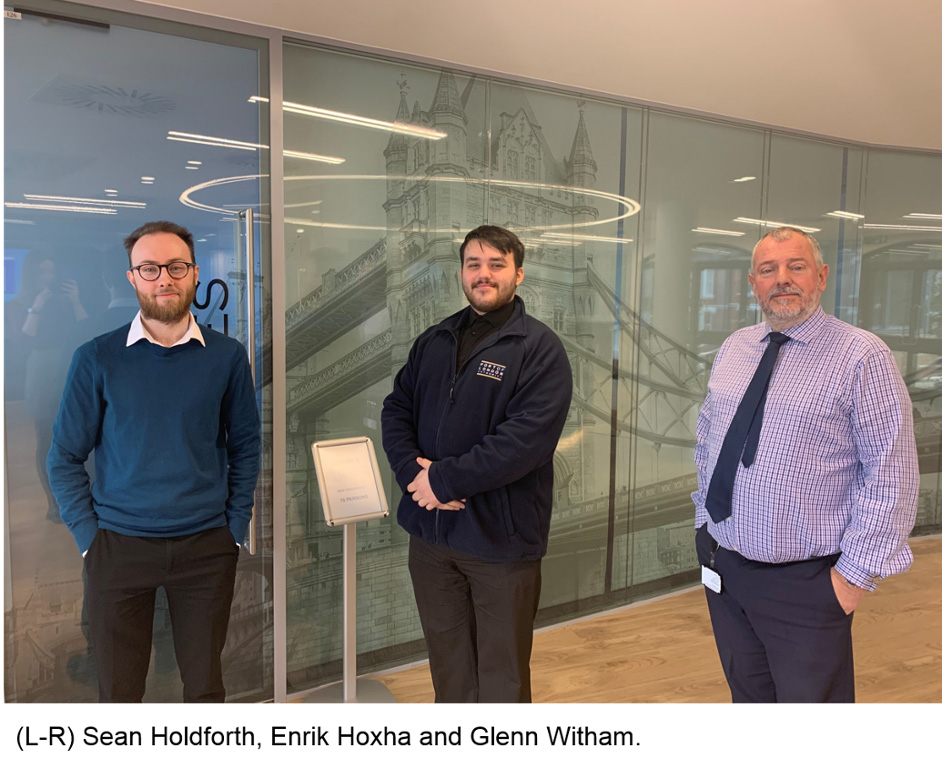
Related content


Location: London/Gravesend Remuneration: £28,971 per annum for a commitment of up to 24 days per...

A port romance revealed
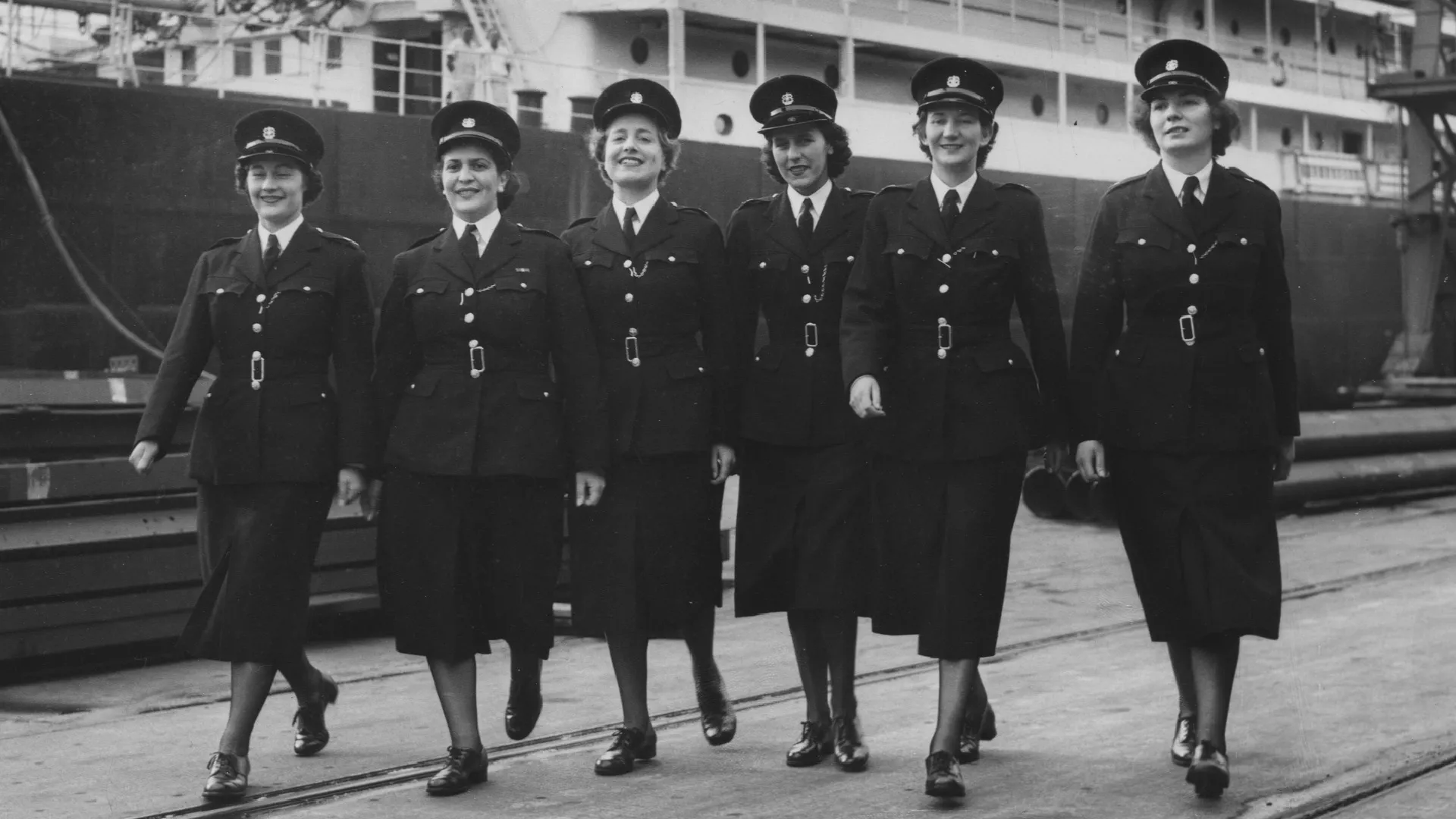
The romance between one of the Port of London’s first female police officers and a former chief planning officer at Havering Council has been revealed, thanks to a new exhibition at the Museum of London Docklands.
A photo of Evelyn Chadderton (nee Thorn, pictured third left, with five other female recruits to the port constabulary in 1954) has been used to promote London: Port City, which chronicles the port’s history over two centuries.
It was spotted in The Guardian by her son, Tim now living in Germany, who contacted the museum to shed light on his parents’ romance.
Tim explained: “My parents first met at the end of the war in Devon – father, Frank, in the army, and mother in the Wrens.
“Mum declined dad’s first offer of marriage in 1946, when she was 19, because she felt she was too young for married life.
“Nine years later, he spotted the picture of her in her uniform in the press and managed to track her down to Ilford, coincidentally next door to Romford, where he was living.
“Six months later they were wed.”
The couple travelled by train and ferry to Pollensa in Majorca, which inspired the name of their family home.
Evelyn, who was crowned “Miss PLA” at Poplar Baths in 1954, died in 2017, Frank in 1982.
They are survived by their three sons, Tim, Richard and Paul.
Today would have been Evelyn’s 96th birthday.
London: Port City continues at the Museum of London Docklands till 8 May 2022.
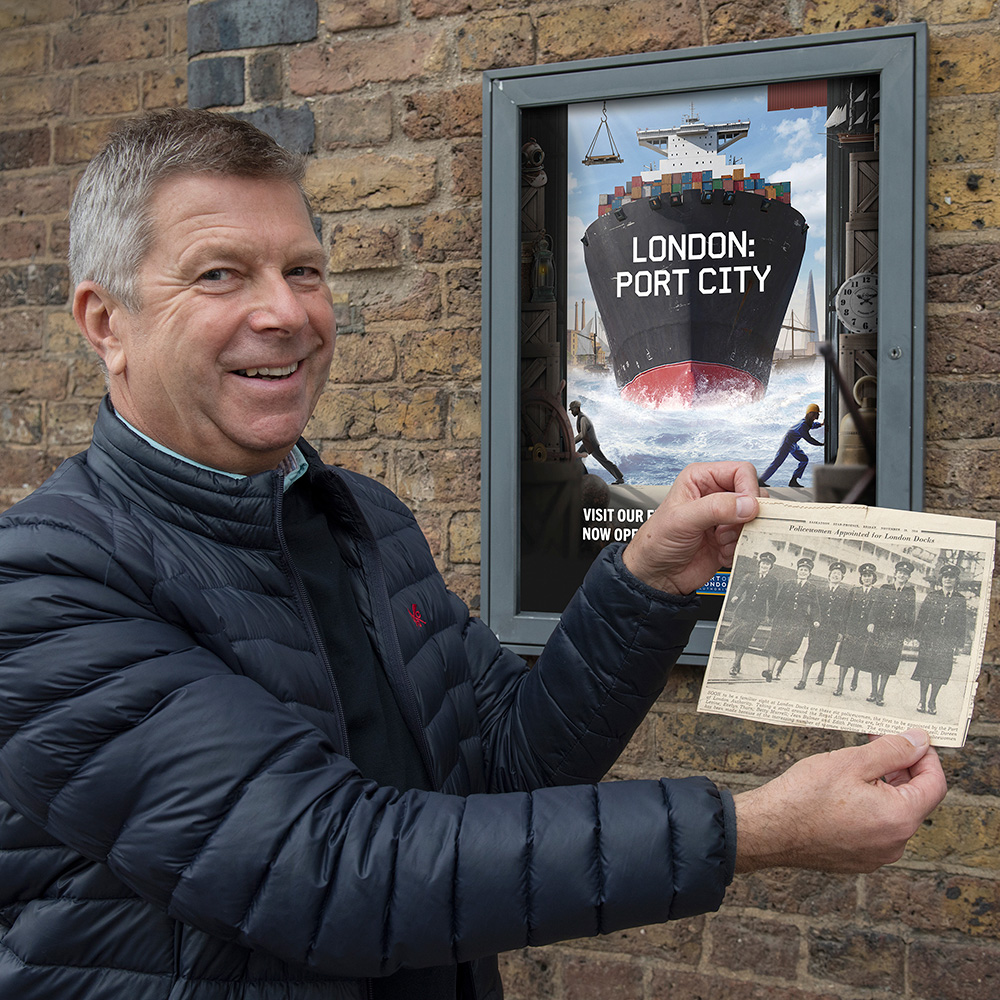
Richard Chadderton outside the Museum of London Docklands at West India Quay.

Richard Chadderton's parents Frank and Evelyn on their wedding day.
Related content


Location: London/Gravesend Remuneration: £28,971 per annum for a commitment of up to 24 days per...

Bring on the river-lution!
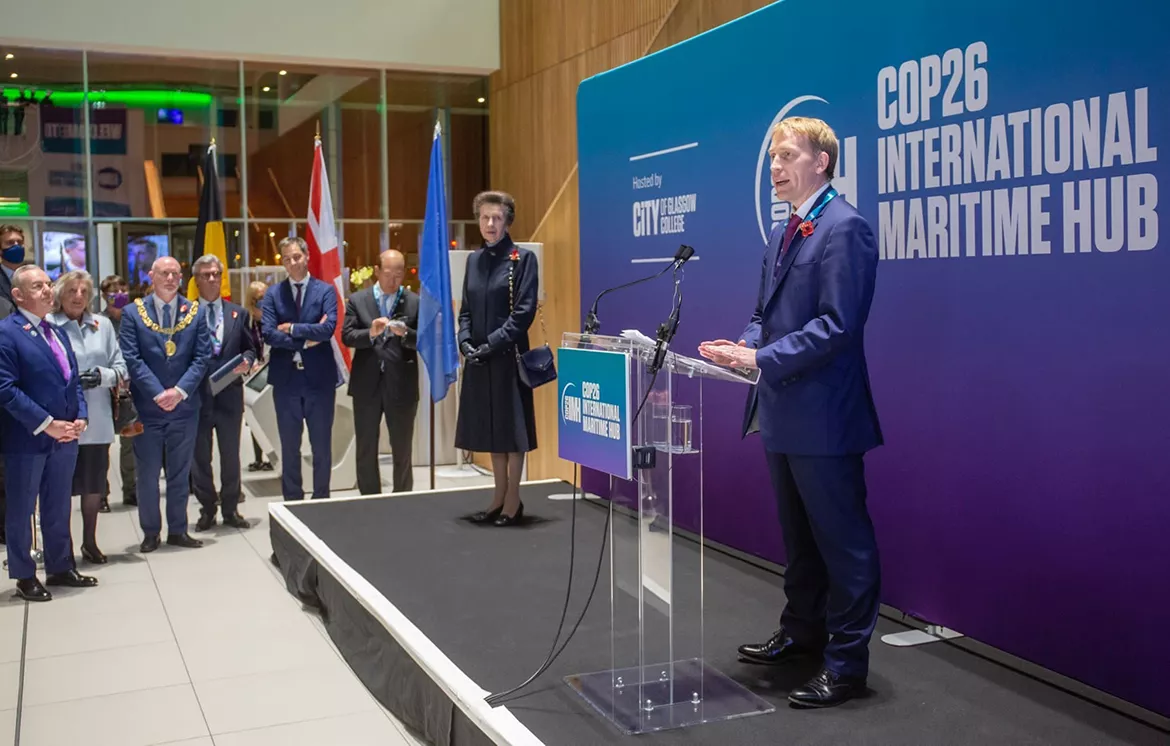
Photo: PLA Chief Executive Robin Mortimer speaking at the International Maritime Hub.
Photo credit: Marc Turner
Robin Mortimer, chief executive of the Port of London Authority (PLA), is looking forward to the tidal River Thames playing its part in delivering Net Zero.
It’s transport day at COP26, and I am feeling optimistic.
There’s no room for complacency, but the mood in Glasgow at the International Maritime Hub, which I attended last week, was extremely positive.
One particularly engaged participant was the Belgian prime minister Alexander Croo.
His country is a key partner for the UK in research on how to best to reduce maritime carbon emissions.
Recently confirmed as the UK’s biggest port by volume, for the first time in over two decades, London is leading the way.
The PLA heads a consortium, supported by Government, working to establish a national Hydrogen Highway, integrating land, sea and port.
This includes trials at Denton Wharf in Kent to establish the business case for vessels on the Thames powered by hydrogen.
Our work with Royal HaskoningDHV to model future energy use on the Thames, in response to climate change, is essential to ensure that the port remains competitive in the long term.
Feasibility studies are also planned by Uber Boat by Thames Clippers and Cory to develop the vessels that can make Net Zero possible on the river.
Actions not words
We recognise the need to practice what we preach.
Thanks to funding from the Cross River Partnership, work is underway to reduce nitrogen oxide emissions from Driftwood II, one of our river maintenance vessels.
As part of our air quality strategy, the first to be produced by a UK port, we also offer incentives to larger visiting vessels to exceed the minimum required environmental standard.
Additionally, our Thames Green Scheme encourages operators to improve the sustainability of their fleet.
Later this month, in partnership with Thames Marine Services, we will take our first bulk delivery of lower-emission biofuels at Royal Terrace Pier, near our Gravesend headquarters.
Barrier Gardens Pier in Woolwich will follow suit in December, as part of a major refurbishment to make our operations there safer, quieter and greener.”
Freight opportunity
Meanwhile, significant progress is being made towards the Thames Vision goal of increasing the volume of freight carried on the river.
The importance of this is underlined in the Centre for London’s new report (Worth the Wait: Making London’s Deliveries Green and Smarter).
Tideway, the company building London’s much-needed ‘super sewer’, has blazed a trail on “more by river”.
So far, five million tonnes of material for the project have been transported by river, saving 600,000 HGV journeys and 14,816 tons of carbon dioxide emissions.
Others are making a difference too, also aided by our work over decades to ensure the river did not lose its protected wharves.
Roof parts for Fulham FC’s new stand, for example arrived in the capital by barge from Tilbury.
As the economy changes post the pandemic, getting more light freight onto the river is a major opportunity.
This summer’s trial by CEVA Logistics and Livett’s Launches to ferry medical goods twice a day from Dartford to Guy's & St Thomas' Hospital has been a success.
More initiatives to utilise the river for the delivery of goods ordered online are in the pipeline too.
No plain sailing
It would be wrong of me to suggest greening the river will be easy or quick.
Restoring passenger numbers on the river to pre-covid levels is a pressing challenge, for example.
But we are committed to doing all we can to decarbonise the economy of the river.
The Thames has shaped London’s past and can shape its future too.
Related content


Location: London/Gravesend Remuneration: £28,971 per annum for a commitment of up to 24 days per...

Granddaughter’s designs for veteran PR man at new Port of London exhibition
Esther Johnson, the designer responsible for gifts linked to a major new Port of London exhibition at Museum of London Docklands, took inspiration from her grandfather, a retired Port of London Authority (PLA) public relations officer.
Her designs for London: Port City merchandise pay tribute to her grandad’s 27-year career at the PLA.
Roy Johnson’s work promoting the port, from 1956 to 1983, covered exhibitions, the production of books, guides, films and photography, as well as school visits and community talks. He lives in Rainham, Kent.
Esther, who lives in Medway, said: “For as long as I can remember, Grandad has loved sharing his stories about working for the PLA – including a number of helicopter filming missions over the river.
“The connection with him has made work on this range, my first for the Museum of London, a real honour. It’s a once-in-a-lifetime opportunity.
“My aim with the design was to reflect the wide variety of goods handled in the port, including animals, spices and wine.
“I was also particularly keen to incorporate the fantastic picture from the PLA archive at the museum, showing port police officers jumping into the river in a training exercise.”
In honour of his time at the PLA, Esther has woven Roy’s initials, RDJ. into the designs – on the side of a London bus, another one of his passions.
Roy said: "It is fantastic to have Esther designing the merchandise for this exhibition, which evokes so many memories for the many people like me, who have worked in the port over the years."
Roy has kept extensive notes, photos and cuttings, covering his career at the PLA, including a hand-written script he used for tours of the river.
For his 80th birthday in December 2019, Esther, who started her business, Designed by Esther, with the support of The Prince’s Trust charity, drew Roy a picture of the old PLA headquarters building, overlooking the Thames in the City of London.
London: Port City continues at the Museum of London Docklands till 8 May 2022.

Related content


Location: London/Gravesend Remuneration: £28,971 per annum for a commitment of up to 24 days per...

Trolley folly in the Thames at Gravesend
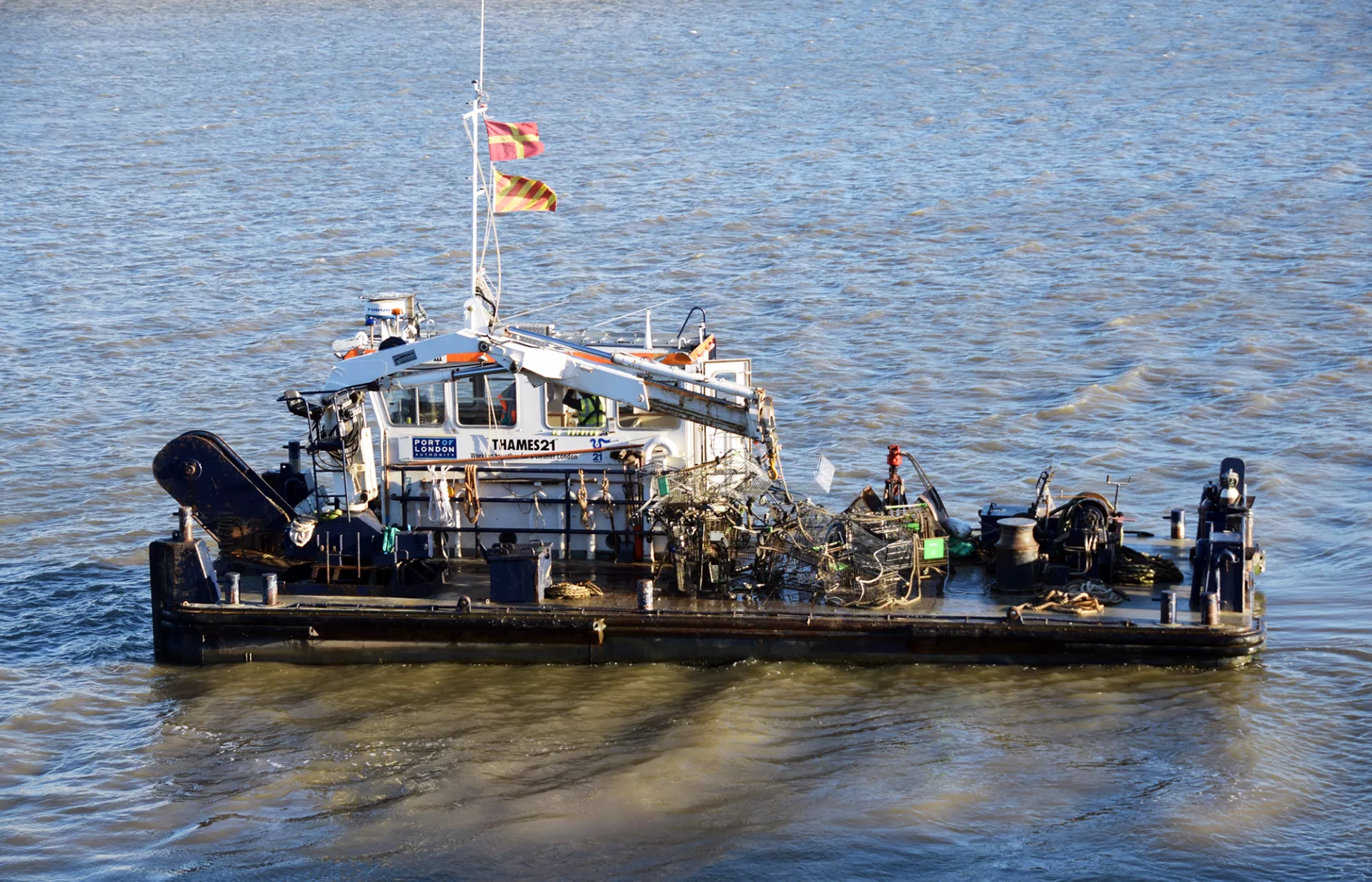
Shopping trolleys dumped in the River Thames near Gravesend have been retrieved by the Port of London Authority (PLA).
New pictures, taken by local photographer Fraser Gray, have been released, coinciding with London Rivers Week (23-31 October), showing the PLA’s Marine Services team rescuing over a dozen discarded trolleys stuck in the foreshore mud, near Imperial Business Park in the Kent town.
Part of the 200-plus tonnes of litter removed from the river each year by the PLA, the trolleys were taken for safe disposal ashore, aboard Driftwood III, a PLA vessel which patrols the river for litter and objects, such as tree branches, with the potential to hamper safe navigation of the river.
The PLA’s marine manager afloat, Michael Russell, said: “We work hard all year round to remove litter of all shapes and sizes from the tidal Thames, from Teddington to the coast.
“Our message to all shoppers is please always return your trolleys to the designated supermarket collection points.
“Left stranded anywhere near by the river, they can all too easily end up in the deep mud of the river’s banks, posing a unnecessary hazard both for river users and wildlife, not to mention the eyesore they create.”
Related content


Location: London/Gravesend Remuneration: £28,971 per annum for a commitment of up to 24 days per...

London: Port City – major new exhibition
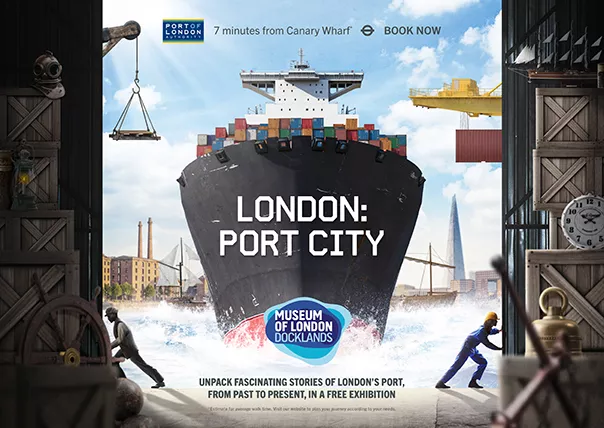
A major exhibition, now open, brings the history – and future – of the country’s biggest port to life.
Filled with fascinating stories of people involved in trade on the river over two centuries, London: Port City runs at the Museum of London Docklands till 8 May 2022.
Featuring a wealth of rarely seen images, housed in the Port of London Authority (PLA) archive at the museum, must-see exhibits include:
- Spectacular, large-scale projections of the river, simulating a day in the life of the port, including a virtual tour of the PLA’s river traffic control room in Gravesend.
- A tracker, monitoring the live movement of trade vessels on the Thames. Annually, the port welcomes over 12,000 commercial vessels, connecting over 80 countries worldwide.
- An interactive timeline, using 221 artefacts, ranging from sandals used to smuggle opium, to the original plans for the docks.
- How the docks influenced language, inspiring the naming of places, pubs and streets in the capital.
- An aromatic tour of the port, featuring smells of imported goods, fragrant and not so fragrant!
- A look at how the river has provided a backdrop for film and TV blockbusters, from Harry Potter to James Bond.
- The engineering feats that became a blueprint for docks around the world.
- Susan Stockwell’s Trade Winds, London, a flotilla of boats, floating on a sea of coins, crafted from international paper currency, maps and travel tickets.
- A new artwork by Hilary Powell, using experimental photographic techniques to explore the container shipping industry and its workforce.
- Paintings, drawings and maps charting the port’s development, including an unseen drawing signed by Marc Brunel (father of Isambard), who designed the Thames Tunnel at Rotherhithe, the first north-south tunnel under the river.
- An exploration of the work of PLA divers over the years, featuring a 1920s helmet and air pump.
The exhibition also investigates the port’s early dependence on the sugar trade and slavery.
A document commemorating the original unveiling of the statue of merchant and slave owner Robert Milligan, which was removed from outside the museum in 2020, will be displayed, alongside original plans for the docks.
Claire Dobbin, curator, Museum of London, said: “The port has had a profound impact on London - physically, economically and culturally.
“With this exhibition we wanted to bring the significance, scale and dynamism of port operations – past and present - to life, as well the experiences of those working on the docks.
“Historic film and photographs, artworks and artefacts, archival documents and oral histories bring personal stories and professional insight from the past into new light, while specially commissioned film and audio-visual displays create a window on to contemporary working practices.
“Visitors can step back in time, to engage with the historic sights, sounds and smells of the docks, and also explore behind the scenes of the PLA’s current activities, which continue to play a vital role in our daily lives.”
Robin Mortimer, PLA chief executive, said: “This brilliant exhibition is a timely look at how the River Thames has driven the economy of London and the country, through tough times and good. It comes as London has recently reclaimed the top spot as the UK’s biggest port.
"The exhibition shows that there is a huge amount to celebrate in the life of the Thames, but also rightly does not shy away from the uncomfortable parts of its history – in particular showing the port’s role in the slave trade.”
“I hope people from far and wide will enjoy exploring not only the port’s history, but also its future, as we work towards a more sustainable and more inclusive world.”
Related content


Location: London/Gravesend Remuneration: £28,971 per annum for a commitment of up to 24 days per...

Behind the scenes at the museum
Kate Cameron

From pleasure boat barmaid to volunteer guide at the PLA’s new London: Port City exhibition at the Museum of London Docklands, Kate Cameron’s seven decades have revolved around the tidal Thames.
Life-long links
“I have lived near the river for most of my life. It becomes part of you.
“If you work on the river, your life is the river. It completely defines you.
“For me, it’s a people thing.
“The River Thames is London.
“It’s the reason why the city has become the magnificent place it is today.
“In the heyday of the old docks, the river not only meant jobs on boats, it also sustained pubs, cafes, newsagents, you name it.
“As London: Port City shows, trade on the river has permeated into the language of the capital too – for example, influencing the names of places, streets and, of course, pubs.
“I just love that sense of belonging that history provides.”
Listening to London
“It’s been an honour to be one of the Londoners who have helped and advised the exhibition curators.
“Rifling through the museum’s audio archives triggered so many memories for all of us who volunteered to be part of the Listening to London project.
“Even via Zoom, we could not stop talking.
“Truth be told, even though the formal sessions are over, the conversations continue on a regular basis.
“With the lockdowns finally consigned to history, it’s great to be able to do so in person now.”
Living history
“It gets me thinking, in a hundred years’ time, what will future generations think of the pandemic?
“It’s a good reminder for everyone to share your recollections – written or verbal.
“You are never too young to start living history.”
Oral histories
“Over the years, I have met so many characters.
“It’s hard to know where to begin. The Prentices, the Dwans, the Bulmans…. the list goes on.
“It’s why I am so looking forward to being a guide at London: Port City.
“It will be the perfect opportunity to remember all the people I have met and retell their stories.
“One of my own earliest memories is my mother describing how the Thames glowed orange during the Blitz, reflecting the inferno of flames from buildings bombed along its bank.
“I remember her words to this day. They painted such a vivid picture in my mind.”
Magic moments
“There are so many great river moments that stand out in my memory.
“I vividly recall back in 1977, the year of the Queen’s Silver Jubilee, I was pregnant with my daughter, Jane. Loads of boats were moored in Westminster.
I was determined to speak to a mate, who was on another boat. I crawled through the stern windows of the boats. It was the easiest way to get to her, as river traffic had been halted.
“Over three decades later, no-one who was lucky enough to take part will forget the Queen’s Diamond Jubilee Pageant in 2012, despite the torrential rain that day.
“Being on the river on New Year’s Eve is always special too.
“On a boat near Parliament, the bongs of Big Ben at midnight reverberate through your whole body.
“It will be so good to celebrate the arrival of 2022 out on the river again.
“There have been political moments too.
“I was on the picket line when the original docks closed.
“Nor will I forget, years later, Colin’s satisfaction, as a freeman of the river, being able to instruct Margaret Thatcher’s vessel to move, as it was obscuring my view of a meridian line laser display over the river.”
West End girl
“My own river story began at the original Westminster Hospital, where I was born.
“My education took me as far afield as a convent school in Crystal Palace, but I grew up nearby, close to Chelsea Bridge, in Pimlico, and clearly remember the waste disposal tugs at Grosvenor Dock, now home to apartment blocks.
“My maternal grandfather was closely involved in bridge repairs locally.
“The world was a smaller place back then.
“I remember setting off to Greenwich for the day with a friend once. I had no idea you could get there and back in a day – so packed a suitcase.”
Matches, hatches, and dispatches
“After a spell working in Scotland, I got a job serving at the Wandsworth Bridge Tavern, where I soon met my former husband, Colin, who was a freeman working on the river, following in the footsteps of his father, Cornelius, known to all as simply “Connie”.
“Dating the local barmaid was a competitive ritual for river workers in those days. I suspect it still is…
“It only took Colin some twenty years to claim the winnings of his bet with his friend that he would succeed in asking me out first.
“I remember Colin out on the river, using sign language to relay the news of our engagement to his mates aboard other vessels. Life on tugs was hot, smelly and noisy.
“Both my children were born a stone’s throw from the river at Guy’s Hospital.
“Everyone knows one another in the river community.
“I started work behind the bar on tourist and party boats in 1995, when Colin and I separated.
“Often, we would engineer for wedding parties to reach the pool of London, just as Tower Bridge was raised.
“Every bride was convinced it had been arranged just for them.
“One of my favourite tales of river life emerged hearing a 1989 museum recording of a conversation with Charles Lunn, a Rotherhithe café owner.
“It’s a story, passed down from generation to generation, about an open coffin, which was washed out of an open window in Gulliver Street during the floods of 1921 – to be retrieved by boatman, Dido Plum, who had been delivering supplies by boat to stranded locals.
“It sums how up how river folk look after each other, through thick and thin.”
River scents
“It’s no exaggeration to say you used to be able to tell where you were on the river, just through your nose, especially on foggy days.
“I personally remember smelling the bricks in the wharves, especially the aroma of spices.
“Also, how boat ropes’ aroma’s varied by season - frozen in winter, steaming in summer.
“Call them odorous or fragrant, smells are a key feature of London: Port City – not to be missed!”
Museum geek
“London and its river are so special to me. I have always loved museums too.
“As my family will happily confirm, I also love talking.
“So being on hand to chat to visitors at London: Port City, well it’s the perfect gig. What’s not to like?
“I am very much looking forward to meeting visitors from far and wide.
“It will be great to hear their memories of the port and how things have changed over the years.”
Youth appeal
“I think children in particular will love London: Port City.
“It’s the perfect destination for a half-term day out.
“The design team have done a tremendous job in making it accessible to people of all ages.
“There is truly something for everyone. And its free!
“Forget the museums of days gone by, all dusty cabinets and endless text.
“This exhibition is a truly interactive experience, bringing the story of London’s port to life.
“There is one section where the children put bricks of the place names into a pretend wall
“I think the adults will have a great time ‘helping' the children.
“Look out for the whale poo too….”
Past, present and future
“My river journey started as a resident of the north shore of the Thames, when the communities either side of the river were very different; even the language we used was different – “car” in the north for example, “motor” in the south.
“Over the years, the differences have become much less pronounced.
“These days, I am firmly at home on the southern shore, living just a stone’s throw from the Woolwich ferry terminal.
“I love watching the boats cross the river to and fro. It’s hypnotic.
“And, given my passion for history, it’s great to be on the doorstep of Maritime Greenwich.
“I am also lucky to have my children and grandchildren living nearby.
“My daughter Jane, who was the first female to become a freeman of the river in 1993, before joining the PLA, now works on river-related matters for the union UNITE.
“James, my son, is in charge of lighterage for Cory, based just up the road in Charlton, continuing the work his father did for the company back in the 1970’s.
“Jane was apprenticed in 1993, James the following year.
“It’s too early to say whether my grandchildren will follow them into maritime careers.
“But I would not be surprised if they did.
“The river seems to be in our blood.”
Quick fire
- West End or East End? That’s not difficult. East End.
- Favourite spot on the Thames? At the back of a boat on the river. Watching the sun come up over London is magical.
- Summarise the river in three words: I can do no better than “boozers, bompers and bridgers”, the title of a book by Con Maloney of the Friends of Island History Group.
- Sources of relaxation? I am a great lover of Kpop bands, as such SHINee, BTS and Third Line Butterfly.
Additional information:
- Listening to London is supported by the Esmée Fairbairn Collectors Fund - delivered by the Museum Association.
- Take a look at the London: Port City Virtual Exhibition Tour.
Related content


Location: London/Gravesend Remuneration: £28,971 per annum for a commitment of up to 24 days per...

Discover
